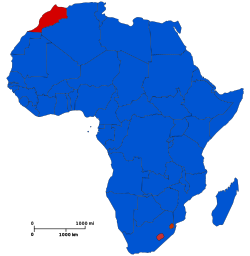
Monarchy was the prevalent form of government in the history of Africa, where self-governing states, territories, or nations existed in which supreme power resided with an individual who was recognized as the head of state.[1] Many such states exist today. All are similar in that the sovereign inherits their office and typically keeps it until their death or until their abdication.
However, only three are currently sovereign, while the remaining are sub-national monarchies.[2][3] Two of the former are constitutional monarchies (Lesotho and Morocco), in which the sovereign is bound by laws and customs in the exercise of his or her powers, and one is an absolute monarchy (Eswatini), in which the sovereign rules without bounds. The sub-national monarchies are not sovereign and exist within larger political associations, such as the Ashanti of Ghana, Bini of Nigeria, and the Xhosa and Zulu of South Africa. In addition to these, there are also three dependencies of two European monarchies—Saint Helena, Ascension and Tristan da Cunha of the United Kingdom and the Canary Islands and Ceuta and Melilla of Spain.
- ^ "The Kings of Africa: 18 Portraits by Daniel Laine". TwistedSifter. 2 July 2012. Retrieved 4 January 2016.
- ^ Mfonobong Nsehe. "The 5 Richest Kings In Africa - page 1". Forbes. Retrieved 4 January 2016.
- ^ Mfonobong Nsehe. "The 5 Richest Kings In Africa - page 2". Forbes. Retrieved 4 January 2016.